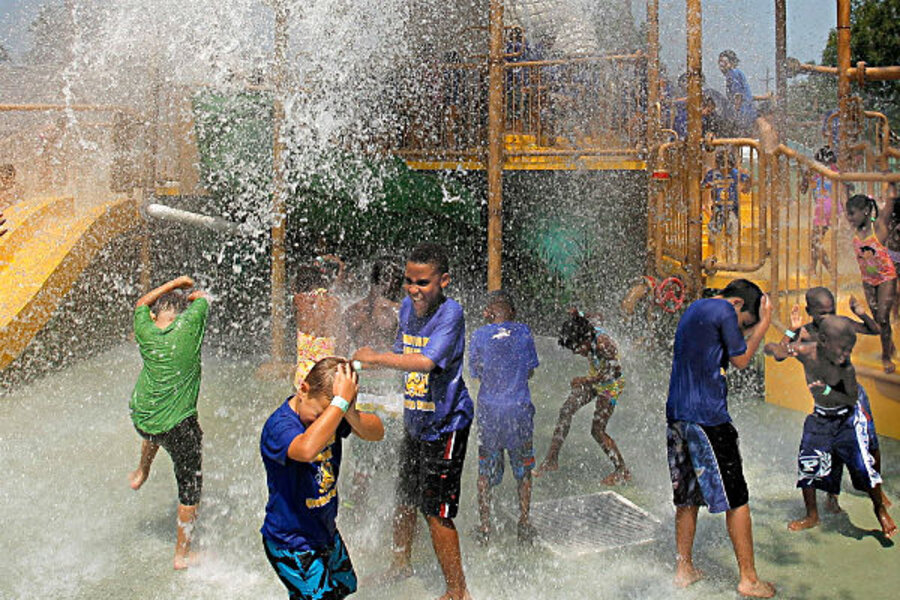US heat wave: Three-digit temperatures recorded across Midwest
Loading...
| Kansas City
Temperatures soared across the Midwest on Thursday, reaching a blistering 108 degrees Fahrenheit (42 Celsius) in St. Louis, and possibly causing two deaths in KansasCity, Missouri, as a massive heat wave pressed eastward from the Rockies.
In Kansas City, where the temperature rose to 105 (40 C), the city health department said two deaths were being investigated to determine if they were heat-related.
A massive high-pressure system over the Midwest caused triple-digit temperatures in Chicago and several other cities. The oppressive heat is expected to linger for several days.
The searing heat presented a challenge for the St. Louis Zoo, which provided misting machines, large fans and cooling stations for visitors and took steps to cool down the animals.
"When it gets hot like this, we like to take a bone and freeze it into a big block of ice then throw it into a pool where the big cats can play with it," said Jack Grisham, who heads the zoo's animal collection. "We'll freeze bananas and oranges and throw them to the primates as well."
Hill City, Kansas, which has been the hottest spot in the nation for five days, reached 108 (42 C) Thursday afternoon, the National Weather Service said. The thermometer hit 115 (46 C) on Wednesday in the northwest Kansas farm community.
"It feels like you have a big old furnace blowing in your face," said Rayson Brachtenbach, a technician at Elliott Plumbing, Heating, Air Conditioning and Electric in Hill City.
Brachtenbach said the hot weather kept the company busy repairing air conditioning systems.
A city in the Midwest having the nation's high temperature for five days in a row is very unusual, said Chris Foltz, a weather service meteorologist in Goodland, Kansas.
"It's what you expect in the desert of Nevada or California," Foltz said.
Sustained heat
Drought conditions have contributed to the early and sustained heat this summer, said Alex Sosnowski, expert senior meteorologist at AccuWeather.com.
"A lot of these places haven't had a lot of rain, and dry soil contributes to heat," Sosnowski said, when asked why the high temperatures are being seen so early in the summer. "The sun's energy doesn't go into evaporating moisture, so it heats the ground and that heats the air. It takes a really big rainfall event to bust a drought like this."
Though scattered thunderstorms are expected to dial down the heat in the Midwest on Friday, Sosnowski does not see anything that would make much of an impact in dry areas.
The weather conditions have contributed to Colorado wildfires that have destroyed hundreds of homes. The heat and drought conditions also are damaging crops. U.S. corn prices have soared 17 percent this month as the hot dry weather persists in the main growing area of the Midwest.
Farther to the east, it was 102 (39 C)in Cincinnati and 103 (39 C) in Nashville, Tennessee.
"It's when you stop sweating and you get goose bumps that you worry," said Sean Lachendro, one of a trio installing fiber-optic line for T-Mobile along a south Nashville roadside.
In Chicago, the high temperature reached 100 degrees (38 C) for the first time in seven years. Summer school was closed Thursday for 10 Chicago public schools without air conditioning.
In Indiana, burn bans are in effect in 74 of 92 counties, and 45 counties have restrictions on shooting off fireworks.
With temperatures soaring, officials from Kansas to the Carolinas asked residents to take steps to stay cool and check on friends and neighbors. In Birmingham, Alabama, police were checking on the sick and elderly.
"We want to ensure our citizens remain safe during the excessive heat outbreak," Birmingham PoliceChief A.C. Roper said. (Reporting by Mary Wisniewski, Kevin Murphy, Bruce Olson, Tim Ghianni, Christine Stebbins, Keith Coffman, and Susan Guyett; Editing by David Bailey and Stacey Joyce)







